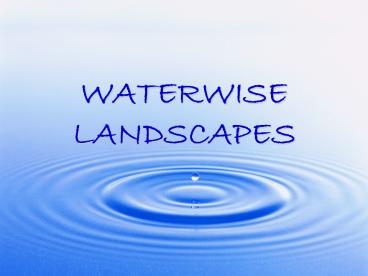WATERWISE LANDSCAPES - PowerPoint PPT Presentation
1 / 37
Title:
WATERWISE LANDSCAPES
Description:
WATERWISE. LANDSCAPES. Proper Planning and Design. Site analysis. Identify microclimates ... Water is slow to infiltrate clay soils leading to excessive runoff ... – PowerPoint PPT presentation
Number of Views:67
Avg rating:3.0/5.0
Title: WATERWISE LANDSCAPES
1
WATERWISE LANDSCAPES
2
Proper Planning and Design
- Site analysis
- Identify microclimates
- Grading and drainage
- Consider function in design
- Porous hardscapes
3
(No Transcript)
4
(No Transcript)
5
(No Transcript)
6
Soil Improvement
- Think about the roots
- Water is slow to infiltrate clay soils leading to
excessive runoff - Poor drainage leads to root problems
- Sandy soils dry out rapidly and do not retain
nutrients - Amend soils with compost
7
(No Transcript)
8
(No Transcript)
9
Appropriate plant selection
- Plants adapted to area
- Microclimates right plant right place
- Consider natives
- Group plants according to water needs -
hydrozones
10
(No Transcript)
11
THE ROOT FLARE
- Trees develop a buttressing flare of roots which
grow radially away from the trunk - This flare is important for supporting the
tremendous amount of weight that develops with
time - Roots should grow away from the trunk and down
into the soil - Soil over top of the root flare will cause the
development of upwardly growing roots which have
the potential of girdling the tree over time
12
(No Transcript)
13
(No Transcript)
14
(No Transcript)
15
(No Transcript)
16
(No Transcript)
17
Practical Turf Areas
- Turfgrasses require twice the amount of
irrigation that woody plants do - Turf areas are more maintenance intensive
- If installing irrigation, size turf areas based
on sprinkler heads - Turfgrass does not compete well in the shade of
vigorously growing trees - Consider other groundcovers
18
(No Transcript)
19
Efficient Irrigation
- Create zones according to water use
- Use drip irrigation where practical
- Water early in the morning to reduce loss to
evaporation and reduce disease problems - Water deeply and infrequently
- Calibrate your sprinkler system
- Install rain shut-off devices/moisture sensing
devices - Avoid runoff
20
(No Transcript)
21
(No Transcript)
22
Use of Mulches
- Use organic mulch
- Apply two to four inches
- Keep away from trunk or crown of plant
- Conserves moisture
- Modifies soil temperature
- Reduces runoff
- Reduces weeds
23
(No Transcript)
24
(No Transcript)
25
Appropriate Maintenance
- Raise mowing height
- Keep mower blades sharp
- Aerate lawns annually
- Fertilize based on soil analysis
- Do not fertilize if the soil is dry
- Keep fertilizers and pesticides on target and
clean up non target areas after application - Check irrigation system frequently
- Keep plants healthy through proper pruning
26
(No Transcript)
27
(No Transcript)
28
(No Transcript)
29
Pest Management
- Healthy plants reduce pest problems
- Proper pest identification keep records
- Know your beneficials
- A diversity of flowering plants attract many
adult beneficials - Use least toxic alternatives that will get the
job done read and follow label directions - Natural (organic) pesticides can kill beneficials
too - Do not apply to plants in flower when bees are
active
30
Lady Beetles
31
Lady Beetle Life-cycle
32
Parasitic wasps
33
(No Transcript)
34
Serphid Fly
35
Green Lacewing
36
Lacewing life-cycle
37
QUESTIONS































